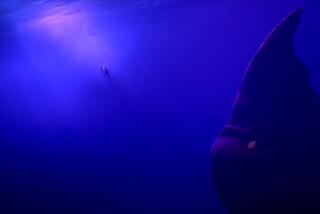From deep in the past
- Share via
The Sea of Dragons :Predators of the Prehistoric Oceans;Richard Ellis;University Press of Kansas: 314 pp., $29.95
*
THIS is a wonderful, complicated grab bag of a book. “The Sea of Dragons: Predators of the Prehistoric Oceans” will appeal to paleontologists and to people who never saw a taxonomic puzzle they could resist. It may attract casual readers, who should feel free to dip in, as it were. Here and there it also might entice the child or teenager who, by contemplating the book’s murky wonders, may be drawn into the exhilarating exploration of the natural world.
“The Sea of Dragons” is about the reptiles that lived in Earth’s oceans from 248 million to 65 million years ago, when they became extinct. That period is generally called the Mesozoic -- divided, starting from the earliest, into the Triassic, the Jurassic and the Cretaceous. The marine reptiles are classed as ichthyosaurs (fishlike lizards), mosasaurs (something like fish, something like crocodiles) and plesiosaurs (meaning closer to modern reptiles).
Author Richard Ellis candidly says this text was “rescued from the scrap heap” of his admired 2001 book “Aquagenesis: The Origin and Evolution of Life in the Sea.” Part of the attractiveness of “Sea Dragons” lies in the 51 line drawings he has done of the creatures he writes about. He sent the sketches around the world to experts for their opinions -- “too fat; neck too short; stripes too prominent” is one critique he shares.
In truth, we don’t know what their coloring was, or what they actually looked like. All are reconstructed imaginatively, from fossils and even small pieces of bone. In the 19th century these sea creatures were very popular in England and Europe, where their remains were first found -- before those of the dinosaurs.
Some were very large. In 1780 in Maastricht, Netherlands, the first mosasaur, Mosasaurus Hofmanni, was discovered. It was 58 feet long. Ellis conjectures that with its powerful jaws and teeth it preyed on many creatures, including hard-shelled turtles.
One of his delightful drawings shows a shastasaurus, an ichthyosaur named for California’s Shasta County, chasing squid. Its handsome spots are imaginary, for no skins survive.
Ellis reminds us that the saltwater crocodile and the leatherback turtle, the largest living marine reptiles, are descendants “of ancient lines whose origins preceded that of the ichthyosaurs, plesiosaurs and mosasaurs.”
“Living birds are now considered the lineal descendants of dinosaurs,” he writes, “so we can ‘see’ dinosaurs just by looking at our bird feeders.
“Like so many large, dominant groups of animals in the history of life on Earth,” Ellis says, “the large marine reptiles are gone, and they left no descendants.”
Why did they go? The current scientific consensus converges on an asteroid striking the Yucatan Peninsula 65 million years ago, an event that more or less coincided with the disappearance of the large terrestrial dinosaurs. But, Ellis says, while the land dinosaurs disappeared in a cataclysmic event, it is believed that the extinction of the great sea creatures took 20 million years, concluding with a “final curtain call” at the time the terrestrial dinosaurs died out. Shrinking oceans may have been a contributory reason; also, perhaps, volcanic eruptions. We just don’t know.
Ellis sagely concludes his intriguing book with a careful, contemplative quotation from Charles Darwin:
“We need not marvel at extinction; if we must marvel, let it be at our own presumption in imagining for a moment that we understand the many complex contingencies on which the existence of each species depends. If we forget for an instant that each species tends to increase inordinately, and that some check is always in action, yet seldom perceived by us, the whole economy of nature will be utterly obscured. Whenever we can precisely say why this species is more abundant in individuals than that; why this species and not another can be naturalized in a given country; then, and not until then, may we justly feel surprise why we cannot account for the extinction of any species or group of species.”
More to Read
Sign up for our Book Club newsletter
Get the latest news, events and more from the Los Angeles Times Book Club, and help us get L.A. reading and talking.
You may occasionally receive promotional content from the Los Angeles Times.










